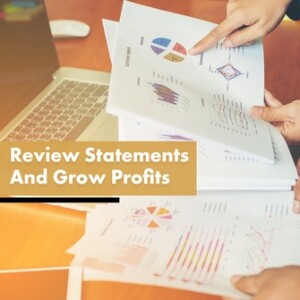Episodes

Monday Jan 22, 2024
Creating a Vision Statement: Your Business’s Guiding Star
Monday Jan 22, 2024
Monday Jan 22, 2024
Welcome, ambitious business owners! Today, we delve into an often-overlooked but critical part of your business plan: the vision statement. This isn't just corporate fluff—it's your business's guiding star, the ambitious declaration of where you're heading. It's not about your current location; it's about the destination you're striving for. It's the GPS setting for your business's journey into the future.
The Challenge of Crafting Your Vision
Many business owners stumble when it comes to articulating their vision. The idea of compressing your vast dreams into a few sentences can be daunting. But fear not! I'll walk you through seven straightforward steps to craft a vision statement that pulses with the lifeblood of your business.
Step 1: Reflect and List Down Your Core Values and Purpose
It all starts with introspection. What are the core values that drive your business? Innovation? Sustainability? Quality? Community? Write them down. All of them. Then ponder the purpose of your business. Why does it exist? What problems does it solve?
Implementing Step 1:
- List your values and purposes.
- Select those that resonate and align with your business goals.
Practical Example:
Take our hypothetical Eco-Friendly Cleaning Products Company. Their values might be environmental sustainability, safety, and transparency. Their purpose? To revolutionize the cleaning industry with safe, green products.
Step 2: Dream Big and Visualize the Future
This step requires you to close your eyes and project yourself into the future. Imagine your business as you wish it to be. What does it look like? How do people engage with your products or services? What impact are you creating?
Implementing Step 2:
- Visualize your business's future in detail.
- Create a vision board highlighting these future aspirations.
Practical Example:
Our Eco-Friendly Cleaning Products Company sees itself as a household name in green living, with products in homes globally, renowned for safety and effectiveness.
Step 3: Consolidate Your Ideas
Look at the work you've done so far. Your notes and vision board contain the raw materials for your vision statement. Find the common threads that weave through your values and future visions.
Implementing Step 3:
- Identify recurring themes from your brainstorming and visualization.
- Synthesize these into a clear direction for your business.
Practical Example:
For our company, themes of 'environmental care' and 'family safety' are prominent. These become the pillars of their vision statement.
Step 4: Draft Your Vision Statement
Now, draft your vision statement. This is a rough sketch, not the final product. It should be succinct but comprehensive, capturing your business's spirit and ambition.
Implementing Step 4:
- Write a draft of your vision statement, keeping it clear and brief.
- Ensure it reflects your business's core values and future goals.
Practical Example:
"Our vision is simple: spotless homes, spotless planet. Our eco-friendly cleaners empower every household to protect the earth."
Step 5: Refine and Finalize
Take your draft and refine it. This is your chance to polish and perfect it. Your vision statement should resonate, inspire, and align with your business's identity.
Implementing Step 5:
- Edit your vision statement, making it more compelling.
- Write multiple versions to find the one that fits best.
Practical Example:
"Our goal is a clean home for you and a clean planet for all. We're here to make eco-friendly cleaning the standard in every household."
Step 6: Get Feedback
Share your vision statement with trusted peers for feedback. They might see things you've missed and provide insights that can sharpen your statement.
Implementing Step 6:
- Seek constructive feedback.
- Use this input to make final adjustments to your vision statement.
Practical Example:
After gathering feedback, our Eco-Friendly Cleaning Products Company might adjust their statement to: "We champion a world where green cleaning is the norm in every home."
Step 7: Implement and Communicate
Your vision statement is ready to become a fundamental part of your business. It should be communicated to your team, included in your marketing materials, and serve as a decision-making guide.
Implementing Step 7:
- Integrate your vision statement into every facet of your business.
- Use it to inspire and guide your team and marketing efforts.
Practical Example:
Our example company would ensure that their vision statement is at the forefront of their branding, product design, and community outreach programs.
Join Our Community
As we wrap up, take this opportunity to join our community at jetresult.today/get. It's a hub where business owners unite to share resources and support each other's growth.
Conclusion: The Heart of Your Business
Crafting a vision statement is about dreaming big and communicating that dream in a way that's clear and grounded in your business's values. It's about creating a beacon that leads you to success. Keep it simple, make it inspiring, and ensure it mirrors the heart of your business.
Remember, a vision statement is more than words on paper—it's the embodiment of your business's dreams and aspirations, a declaration of your journey towards greatness.
To gain access to strategies specifically made for business owners, visit jetresult.today/get. There's a lot to learn – valuable ideas, energizing live sessions, coaching, and more – all in a community commited to growing revenue, profit, cash flow, business value, and personal lifestyle.
#VisionStatement #BusinessPlan #BusinessSuccess #Leadership #NicClark #Jetresult

Friday Jan 19, 2024
Friday Jan 19, 2024
In the world of business, it's no secret that repeat customers are the lifeblood of sustained success. Imagine if your customers kept coming back to your business, not just occasionally, but with unwavering loyalty. This is the power of implementing a rolling timeline of communication. In this article, we will explore how to establish lasting connections with your customers and keep them returning for more.
Step 1: Know Your Customers
To embark on the journey of implementing a rolling timeline of communication, you must begin by truly understanding your customers. Dive deep into their preferences, needs, and purchasing behavior. Whether you run a clothing store or a software company, knowing your customers inside out is crucial. For instance, if you discover that a particular customer prefers casual wear over formal attire, you can tailor your communication to send them relevant offers and updates.
Step 2: Collect Contact Information
To keep your customers engaged, you need a direct line of communication with them. Simplify the process of collecting their contact information. This can be achieved through a user-friendly sign-up form on your website, a customer loyalty program, or even a friendly request during their in-store visit. Once you have their contact details, you can initiate regular communication.
Step 3: Create a Content Calendar
Now that you possess your customers' contact information, it's time to strategize your communication efforts. Establish a content calendar that outlines when and what you'll be delivering to your customers. This content can encompass newsletters, promotions, insightful tips, or even a casual update about your business. The key is to ensure that your content is both valuable and engaging.
Step 4: Personalize Your Messages
Generic, one-size-fits-all messages are outdated. Personalize your communication to make each customer feel special. Incorporate their first names in your emails, suggest products or services based on their past purchases, and acknowledge their loyalty. Customers are more likely to engage with messages that feel tailored to their needs.
Step 5: Use Multiple Communication Channels
Don't limit yourself to just one communication channel. Employ a diverse mix of email, social media, SMS, and even direct mail if it aligns with your business model. Different customers have varying preferences for communication, so diversification enables you to reach a wider audience.
Step 6: Provide Value
Each communication you send should offer genuine value to your customers. Share valuable tips, comprehensive how-to guides, and information that can enhance their lives or address their problems. When customers perceive your commitment to helping them, they are more inclined to stay engaged and return to your business.
Step 7: Ask for Feedback
The input of your customers is priceless. Encourage them to share their opinions and suggestions. Not only does this demonstrate your appreciation for their insights, but it also provides valuable information on areas where you can enhance your products or services. Act upon the feedback you receive to improve their overall experience.
Step 8: Offer Exclusive Benefits
Recognize and reward customer loyalty by extending exclusive benefits to your repeat patrons. This could include discounts, early access to new products, or VIP events. By making your loyal customers feel valued and special, you'll inspire them to continue their association with your business.
Step 9: Monitor and Adapt
Vigilance is essential in managing a rolling timeline of communication. Keep a watchful eye on your communication efforts, tracking metrics such as open rates, click-through rates, and conversion rates. Analyze what is effective and what needs adjustment. Be ready to adapt your strategy based on the feedback and data you gather.
Step 10: Be Consistent
The cornerstone of maintaining a rolling timeline of communication is consistency. Don't start strong and then gradually fade away. Stick to your content calendar, and ensure that communication flows steadily. Consistency fosters lasting relationships with your customers.
Conclusion:
In conclusion, implementing a rolling timeline of communication is the key to building strong and enduring connections with your customers, encouraging them to return time and again. To succeed in this endeavor, it is imperative that you understand your customers, maintain regular communication, provide value, and personalize their experience. By following these steps with dedication and commitment, you can cultivate a loyal customer base that will continue to support your business for years to come. Remember, it's not just about making sales today; it's about nurturing relationships that last a lifetime.
To gain access to strategies specifically made for business owners, visit jetresult.today/get. There's a lot to learn – valuable ideas, energizing live sessions, coaching, and more – all in a community commited to growing revenue, profit, cash flow, business value, and personal lifestyle.
#RollingTimeline #GrowingSales #RepeatSales #ClientCommunication #NicClark #Jetresult

Thursday Jan 18, 2024
Unlocking Business Growth Through Regular Call Cycles with Key Prospects
Thursday Jan 18, 2024
Thursday Jan 18, 2024
Hello and welcome, dedicated entrepreneurs! Today, we're diving into a crucial strategy that can significantly uplift your business – maintaining a regular call cycle with key prospects. In the bustling world of small businesses, the art of communication isn't just about making sales; it’s about building lasting relationships. Stick around as we explore how this approach can become your secret weapon in securing repeat business and ensuring sustainable growth.
The Power of Repeat Customers
Why are repeat customers so vital for your business? For starters, acquiring a new customer can cost five times more than retaining an existing one. Repeat customers also tend to spend more, demonstrating a trust and familiarity with your brand that only deepens over time.
Imagine a local coffee shop, where the barista knows customers by name and their preferred orders. This personal touch turns occasional visitors into regulars. Or consider a tech company that regularly reaches out to its clients, not just for feedback but to offer personalized solutions. These businesses thrive not just on first-time sales, but on the loyalty they nurture.
By focusing on repeat business, you're not just selling a product or service; you're cultivating an ecosystem of loyal patrons who value what you bring to their lives.
The Heart of the Strategy: Regular Call Cycles
Now, let's delve into the heart of our strategy – the regular call cycle. This isn't just a series of phone calls; it's a structured approach to staying connected with your key prospects. Regular calls keep you fresh in their minds, enabling you to understand their evolving needs and preferences. This continuous engagement is key to building trust and showing your commitment to their satisfaction. It’s like a gardener tending to plants; regular care ensures they bloom beautifully. By integrating this into your routine, you transform sporadic interactions into a consistent dialogue, laying the groundwork for lasting business relationships.
Implementing Regular Call Cycles: A Step-by-Step Guide
Now, let's get into the specifics of how you can implement regular call cycles in your business effectively:
1. Identify Key Prospects
Start by identifying who your key prospects are. These are clients who have the potential for repeat business and value alignment with your offerings.
2. Set a Schedule
Establish a routine. Decide how often you’ll reach out – it could be bi-weekly or monthly, depending on your business nature and client preferences.
3. Prepare Your Approach
Tailor your communication. Each call should be more than a check-in; it should add value, whether through industry insights, personalized offers, or simply demonstrating your understanding of their challenges.
4. Record and Analyze Feedback
Keep track of each interaction. Note preferences, concerns, and any feedback provided. This information is gold for personalizing future interactions and improving your services.
5. Be Consistent but Flexible
While consistency is key, be adaptable. If a client prefers emails over calls or a different frequency, adjust accordingly. It’s about creating a comfortable rhythm for both parties.
6. Evaluate and Evolve
Regularly assess the effectiveness of your call cycle. Be open to tweaking your strategy for better results.
Success Stories: Inspiration for Your Journey
Consider the success story of a local boutique that started regular calls to its customers. By simply checking in and offering style advice, they saw a 30% increase in repeat visits. Or a software company that reduced client churn by 25% through monthly check-in calls, addressing concerns proactively.
Conclusion
In conclusion, establishing a regular call cycle with key prospects isn't just a strategy; it's a transformation of your business approach. It's about nurturing relationships that turn customers into long-term partners. Start this journey today, and watch as your small business unfolds into a hub of loyal customers.
In the world of business, where competition is fierce and customer loyalty is priceless, adopting the regular call cycle strategy can set you apart and propel your growth to new heights. Remember, it's not just about making sales; it's about building lasting relationships. So, embrace the power of regular calls and watch your business flourish like never before.
To gain access to strategies specifically made for business owners, visit jetresult.today/get. There's a lot to learn – valuable ideas, energizing live sessions, coaching, and more – all in a community commited to growing revenue, profit, cash flow, business value, and personal lifestyle.
#CallRegularly #RegularCallCycles #RepeatSales #SalesGrowth #NicClark #Jetresult

Wednesday Jan 17, 2024
Unlocking the Power of Customer Data: A Blueprint for Business Growth
Wednesday Jan 17, 2024
Wednesday Jan 17, 2024
In the world of entrepreneurship, where every decision and strategy counts, there's one game-changing approach that stands out among the rest: leveraging client data to skyrocket your repeat sales. Welcome, fellow business owners, to a journey that will transform the way you do business. In this article, we will explore the power of knowing your customers intimately and how it can take your business from uncertainty to becoming a community staple.
Meet Sarah: A Tale of Transformation
Let's begin by diving into the inspiring story of Sarah, the proud owner of a quaint bakery and café. Her establishment, always fragrant with the aroma of fresh bread and coffee, had already won the hearts of the locals. However, Sarah, like many small business owners, faced a common dilemma. She relied heavily on walk-in customers, leading to fluctuating sales based on daily foot traffic and the unpredictable whims of casual patrons. Without comprehensive insights into her customers' preferences and habits, Sarah found it challenging to engage them beyond their occasional visits. This roller-coaster business model was not only stressful but also unsustainable in the long run. The question that loomed over her was simple: how could she transform her business from being at the mercy of chance to becoming an integral part of her community?
But then, Sarah had a brilliant epiphany. What if she could truly know her customers? What if she could anticipate their needs and celebrate their special moments? She started gathering essential data: birthdays, favorite items, special anniversaries, names, emails, and phone numbers. This was not just data; it was a treasure trove of opportunities to create personal connections.
Implementing the Strategy: Your Path to Success
Now that we've uncovered Sarah's remarkable journey, let's break down how you, like Sarah, can implement this strategy effectively. Here are the steps to follow:
Step 1: Identifying What Data to Collect
First and foremost, identify what data will be most valuable to your business. For Sarah, it included birthdays, preferences, and contact information. Consider what is relevant for your business and some ideas to focus on:
Purchase Preferences and Histories: Document not just what customers buy but also what they look at, ask about, or consider. This can guide your inventory and inform personalized recommendations.
Service or Product Feedback: Capture their opinions after a purchase or interaction. This feedback can be used to personalize follow-up communications, showing that you value their input.
Special Occasions: Beyond birthdays, collect data on anniversaries, major holidays, or the date of their first purchase with you. Offering personalized greetings or promotions on these dates can make customers feel special.
Customer Lifestyle Data: Understanding your customers' lifestyles can be crucial. For instance, knowing that a segment of your clientele is interested in health and fitness could lead to targeted offers for health-related products or partnerships with local gyms.
Behavioral Data: Take note of their habits. Do they shop online at night? Do they prefer in-store on weekends? Align your marketing emails or store promotions with these behaviors.
Social Media Engagement: Track which posts they interact with. If they like posts about community events, invite them personally to the next one.
Value of Last Purchase: Customers who make larger purchases might be enticed back with exclusive offers or early access to new products.
Cart Abandonment Data: If you have an online storefront, track items customers leave behind. Follow up with an email offering help or a slight discount to encourage them to complete the purchase.
Replenishment Needs: For products that run out or wear down, keep a timeline. Reach out just before they likely need to replenish, offering a convenient reorder process.
Surveys and Questionnaires: Create opportunities for customers to tell you about their interests and preferences. This can inform how you develop and market your offerings.
Utilization Patterns: For services, monitor how and when your customers use them. For example, if you run a car service shop and notice a customer always comes in before a long trip, send a reminder or a special offer ahead of their next expected trip.
Loyalty Program Engagement: Track their participation in your loyalty program, if you have one. Offer milestone rewards or bonuses that encourage continued engagement.
Exit Interviews or Feedback: If a customer hasn't returned in a while, reach out to understand why. This data is invaluable for making improvements and can sometimes re-engage the customer.
Collecting this type of data requires a thoughtful approach that respects customer privacy and consent. Each interaction with your customers is an opportunity to gather data, but it's also an opportunity to strengthen the relationship. Make data collection a part of your value proposition – ensure your customers understand that their information will be used to enhance their experience with your business. With the right data in hand, you can create a compelling reason for customers to keep coming back.
Step 2: Methods of Data Collection
Now that you know what data to collect, let's explore various methods to gather this information effectively:
Digital Check-in System: Implement a system where customers can check in on a tablet using their email or phone number. Offer an immediate small discount or entry into a monthly draw as an incentive.
Online Purchases and Accounts: Encourage customers to create an account for faster checkouts. During the account setup, ask for their preferences and important dates.
Feedback Forms: After a service or purchase, send a feedback form that includes fields for additional data. Pair this with a chance to win a gift card or service.
Social Media Contests: Run contests on social media that require entrants to fill out a form with their data. Make sure the prize is enticing and relevant to your business.
Wi-Fi Access: Offer free Wi-Fi in exchange for an email address. You can also include an optional short survey for additional data collection.
Events and Workshops: Host events or workshops that require registration. This can be an excellent opportunity to gather more detailed information.
Loyalty Programs: Design a loyalty program that rewards customers for sharing information. The key is to offer tangible value in exchange for their data.
Point of Sale Prompts: Train staff to ask for an email or phone number at checkout, explaining the benefits, like receiving receipts via email or SMS alerts for special deals.
QR Codes: Place QR codes in strategic locations that lead to a data collection form. This can be on the receipt, at the table, or next to products.
Remember, transparency is paramount. Clearly communicate how the data will be used and the benefits to the customer. Ensure there is a straightforward opt-out process for those who value their privacy. By making data collection part of a value exchange, customers are more likely to share their information willingly and enthusiastically.
Step 3: Organizing and Analyzing Data
Once you've successfully collected customer data, it's time to organize and analyze it. Utilize simple tools like spreadsheets or consider specialized Customer Relationship Management (CRM) software like:
- Keep (Infusionsoft),
- HubSpot,
- GoHigh Level, or
- Zoho for small businesses.
The goal is to understand your customers' patterns and preferences deeply.
Step 4: Crafting Personalized Marketing Strategies
With a treasure trove of customer data at your fingertips, it's time to get creative. Sarah used this data to send personalized messages and offers. Imagine a birthday discount or a special anniversary reminder. This creates a unique and memorable customer experience.
Step 5: Evaluating the Effectiveness and Making Adjustments
Once you have implemented your personalized marketing strategies based on the data you've collected, it's essential to continually evaluate their effectiveness. Tracking customer responses and engagement will provide valuable insights into the success of your efforts. Here's how to effectively evaluate and refine your strategies:
Monitoring Metrics: Keep a close eye on key performance indicators (KPIs) such as customer engagement, conversion rates, and sales attributed to your personalized campaigns. Use analytics tools to track these metrics regularly.
Customer Feedback: Encourage customers to provide feedback on the personalized experiences they receive. This can be done through surveys, reviews, or direct communication. Pay attention to their comments and suggestions.
A/B Testing: Experiment with different variations of your personalized campaigns to identify what resonates best with your audience. Test different messaging, offers, or timing to optimize your approach.
Segmentation Refinement: Continuously refine your customer segments based on their behaviors and preferences. As you gather more data, you may discover new segments or opportunities to further personalize your marketing.
Response Analysis: Analyze how customers respond to different types of personalization. Are they more engaged with birthday discounts or anniversary messages? Use this data to tailor your future efforts.
ROI Evaluation: Calculate the return on investment (ROI) for your personalized marketing initiatives. Assess whether the revenue generated from these efforts justifies the resources and expenses involved.
Customer Retention: Measure the impact of personalization on customer retention rates. Determine if personalized engagement leads to longer-lasting and more loyal customer relationships.
Feedback Loop: Create a feedback loop between your marketing team and other departments like sales and customer service. Insights from different teams can help fine-tune your strategies.
Adjustments and Optimization: Based on the insights you gather, be prepared to make adjustments to your personalized marketing strategies. This may involve refining messaging, changing timing, or modifying offers.
Continuous Learning: Stay informed about industry trends and best practices in data-driven marketing. Learning from successful case studies and staying updated on marketing technology can inform your strategy.
Remember that personalization is an ongoing process. As you gather more data and refine your approach, you'll be able to create even more tailored and effective marketing campaigns. The key is to be agile and responsive to your customers' evolving needs and preferences.
Now that your personalized marketing strategies are in full swing, it's crucial to continuously assess their impact. Tracking customer responses and engagement will provide valuable insights into the effectiveness of your efforts. Be prepared to make adjustments based on the data you gather.
Sarah's transformation was nothing short of remarkable. Her bakery evolved from a simple stop for many into a cherished part of her customers' lives. Birthday wishes and tailored treats based on customer preferences made her patrons feel genuinely special. Automated, personalized messages for seasons, anniversaries, and birthdays not only brought smiles but also encouraged repeat visits. The result? Sarah witnessed a significant boost in sales and customer loyalty. Her once unpredictable revenue stream transformed into a growing, thriving business that expanded exponentially year by year.
Applying Sarah's Approach to Your Business
Now, picture applying Sarah's approach to your own business, whether you run a boutique, a service company, or any small business. The principles remain the same: know your customers intimately, engage with them meaningfully, and watch as this investment in relationships transforms your business. It's about creating a community around your brand, where each customer feels valued and understood.
In Conclusion: The Power of Data-Driven Engagement
To wrap up, the key to boosting your repeat business lies in the data you collect and how you use it. It's not just about sales; it's about building relationships. Start small, think like Sarah, and soon you'll see the power of personalized engagement in action. Remember, in the world of business, the most successful ventures are those that truly understand and cater to their customers. So, take the leap, gather that data, and let your business flourish!
As you embark on this data-driven journey to business growth, keep in mind the words of wisdom from Bryan Tracy (although his name is not mentioned in this article): "The true mark of a successful business lies in its ability to connect with its customers on a personal level, anticipating their needs and making them feel valued. Data-driven engagement is the key to achieving this level of excellence."
So, fellow entrepreneurs, let Sarah's story inspire you to take the first step toward transforming your business through data-driven customer engagement. Embrace the power of knowing your customers, and watch your business thrive like never before.
To gain access to strategies specifically made for business owners, visit jetresult.today/get. There's a lot to learn – valuable ideas, energizing live sessions, coaching, and more – all in a community commited to growing revenue, profit, cash flow, business value, and personal lifestyle.
#RepeatBusiness #KeepDataOnClients #RepeatSales #SalesGrowth #NicClark #Jetresult

Tuesday Jan 16, 2024
The Power of Building a Client Database: Fueling Your Business Growth
Tuesday Jan 16, 2024
Tuesday Jan 16, 2024
Welcome, fellow entrepreneurs and small business owners! I'm Nic Clark, a business coach with over 30 years of experience. Today, I want to share a game-changing strategy that can significantly boost your repeat business: maintaining a database of clients. Inspired by the pragmatic approach of thought leaders like Michael Gerber, we'll explore how this simple yet powerful tool can transform your business. Let's dive into the world of client databases and unlock the secret to sustainable growth.
The Importance of a Client Database
In the ever-evolving landscape of small businesses, staying connected with your customers is not just important – it's essential. Imagine this: Frank, the owner of an online retail store, was like many of you. His focus was always on attracting new customers, a strategy that seemed effective until it wasn't. Frank's story reflects a common oversight in small businesses – underestimating the power of repeat customers.
Why is a client database so crucial? It's simple. Without a way to reach out to past customers, you're essentially letting valuable relationships and potential sales slip through your fingers. Frank's experience is a testament to this. He had no system in place to reconnect with customers who had already shown interest in his products. This reliance on continually finding new customers is a risky game, especially when market dynamics change.
The beauty of a client database lies in its ability to foster loyalty and repeat business. It's not just about collecting names and emails; it's about creating opportunities to re-engage customers who already trust your brand. A database allows you to send targeted promotions, updates on new products, and personalized messages that keep your brand at the forefront of their minds.
Frank's Success Story
Let's return to Frank's story. When a sudden downturn hit, new customer sales plummeted. Concerned and seeking advice, Frank turned to me. Together, we realized the untapped potential of his past customers. It was a pivotal moment for Frank. He understood that to sustain and grow his business, he needed to change his strategy. Our solution? Implementing a system to collect client names and email addresses. This step marked the beginning of Frank's journey towards a more stable and profitable business model, emphasizing the value of repeat customers.
How to Build a Robust Client Database
So, how can you, like Frank, build a robust client database? Here's a straightforward guide:
- Start with Your Current Customers: Begin by collecting basic information from existing customers – names and email addresses are a great start. Utilize point-of-sale systems, online checkouts, or even a simple sign-up sheet in your store.
- Choose the Right Tools: Select a database management tool that suits your business size and needs. Options range from simple spreadsheet programs to sophisticated CRM software. The key is ease of use and scalability.
- Establish a Consistent Data Collection Process: Train your team to consistently gather customer information. Whether it's during sales, at events, or through online interactions, make this process a part of your regular business operations.
- Ensure Privacy and Compliance: Always inform your customers about how their data will be used and ensure compliance with data protection laws. Trust is critical in building long-term customer relationships.
- Engage Regularly and Meaningfully: Use the database to send out newsletters, special offers, and personalized messages. Remember, the goal is to add value to your customers, not just sell.
By following these steps, you're not just collecting data; you're building a foundation for lasting customer relationships and repeat business.
The Impact on Frank's Business
Now, let's look at the remarkable impact of the client database on Frank's business. With a growing list of past customers, Frank began reaching out with personalized offers, updates on new products, and exclusive promotions. The result? A significant increase in repeat purchases. Customers felt valued and remembered, fostering a sense of loyalty to Frank's brand. Year after year, Frank saw his business grow, not just through new customers but, more importantly, through satisfied returning customers. His success story is a testament to the power of nurturing customer relationships through a well-managed database.
Conclusion
In conclusion, the journey from a struggling business to a flourishing one, like Frank's, starts with a simple yet effective step: building a client database. It's your gateway to understanding and connecting with your customers on a deeper level.
I encourage each of you to start this journey today. Remember, it's not just about making a sale; it's about creating a community around your brand. Build your database, engage your customers, and watch your business thrive. Thank you for reading, and here's to your success in the world of small business!
To gain access to strategies specifically made for business owners, visit jetresult.today/get. There's a lot to learn – valuable ideas, energizing live sessions, coaching, and more – all in a community commited to growing revenue, profit, cash flow, business value, and personal lifestyle.
#RepeatBusiness #ClientDatabase #RepeatSales #SalesGrowth #NicClark #Jetresult

Monday Jan 15, 2024
Complete Actual To Budget Review
Monday Jan 15, 2024
Monday Jan 15, 2024
Hello, fellow entrepreneurs! Welcome to a pivotal discussion that could redefine the financial health of your small business: the monthly budget review. This seemingly modest routine packs a potent punch, capable of reshaping your financial foresight and decision-making prowess. To illuminate the benefits, let’s trace the transformative journey of Sarah, a dedicated bakery owner whose embrace of this practice revolutionized her establishment. Get ready to uncover the secrets of this simple yet powerful habit and learn how to harness its potential for your own business!
The Importance of Monthly Budget Reviews
In the dynamic arena of small businesses, time translates directly into money, and mastering efficiency is akin to holding the master key to success. Enter the practice of monthly budget reviews, a simple yet profound ritual that empowers you to anticipate financial obstacles, spotlight lucrative ventures, and shape sagacious fiscal choices. To some, it may seem like a sprinkle of sorcery, but it's indeed a strategic mastery of numbers and projections.
Picture Sarah, the enthusiastic proprietor of 'Sarah’s Sweets,' a delightful bakery that could easily mirror the heart of your community. Wearing the hats of a baker, marketer, and accountant, Sarah epitomized the multifaceted role of a small business owner. However, when it came to the bakery's financials, she often felt lost in the fog, unclear about the cost implications of her raw materials against the profits of her delectable offerings. It was the ritual of monthly budget reviews that ultimately illuminated her path, leading to a profound transformation of her business's financial health.
Sarah's Initial Approach and Challenges
Sarah’s story may sound familiar to many. Her financial ledger? A traditional paper trail. Each night, as the bakery’s lights dimmed, she would sit amidst a mountain of receipts and invoices, with a ledger as her guide. Her mission was clear: to diligently track every dime that flowed in and out of 'Sarah’s Sweets.' But as many can attest, simplicity doesn’t always equate to ease.
This manual method was a herculean task, consuming hours that could have been devoted to crafting her renowned pastries. The specter of human error loomed large, with overlooked entries and miscalculations leading to a distorted financial picture. The end of the month brought a particular dread, as she struggled to assemble the financial pieces of her business puzzle. The process drained her—not just of energy but of the creative spark essential for growth and innovation.
Transition to QuickBooks
In a decisive move, Sarah embraced the winds of change and adopted QuickBooks. This transition was transformative, akin to trading a horse-drawn carriage for the efficiency of a modern-day vehicle in the realm of bookkeeping.
QuickBooks presented Sarah with an unobstructed, real-time financial panorama. Automated data input relegated her previous error-ridden manual system to history. Now, a few simple clicks could track expenses, tally income, and even forecast future financial trends. Tasks that once took hours were whittled down to mere minutes, liberating Sarah to devote her newfound time to her passion: baking and business expansion.
But the benefits transcended mere time savings; they opened the door to deeper insights. QuickBooks shed light on which baked goods were in high demand and which were not, enabling Sarah to adapt her inventory intelligently. The monthly budget review transformed from a dreaded chore into a strategic asset, propelling 'Sarah’s Sweets' along the path to profitability.
The Role of a Bookkeeper in Sarah's Business
Yet, the journey did not end with digitalization. Sarah took another quantum leap by hiring a bookkeeper—a decision she initially approached with trepidation. This move, however, proved to be a masterstroke for 'Sarah’s Sweets.'
The bookkeeper arrived with a keen eye for detail and a wealth of financial expertise. Routine accounting tasks were executed with precision, ensuring accuracy and regularity. This collaboration elevated Sarah’s role from mere transaction recording to in-depth analysis. The bookkeeper's insights and advice transformed raw data into a cohesive business strategy.
Most vitally, it afforded Sarah the ultimate luxury: time. Time to indulge in her baking craft, to innovate with new recipes, and to forge stronger connections with her clientele. With her finances in expert hands, Sarah discovered a newfound confidence in her business decisions, propelling her bakery from mere survival to thriving success.
Insights Gained from Regular Reviews
Sarah’s adherence to monthly budget reviews unearthed a treasure trove of insights that were once obscured by the daily grind. She quickly grasped her cash flow's ebb and flow, identifying peak and slow periods, which informed more efficient inventory planning. This knowledge reduced waste and maximized profits.
A meticulous analysis revealed the true costs and profits of her offerings, prompting a strategic menu overhaul that prioritized profitability. Additionally, regular fiscal scrutiny opened up avenues to negotiate better terms with suppliers, armed with concrete purchase data.
Perhaps the most transformative insight was recognizing expansion potential. With a solid financial track record bolstered by disciplined reviews, Sarah secured funding to open a second location a venture that would have remained a dream without the financial clarity she had achieved.
These insights did more than just improve the numbers on a spreadsheet; they narrated the evolution of 'Sarah’s Sweets,' depicting a business in the midst of growth and prosperity. Each budget review session became less about number crunching and more about strategic planning, charting a course for the bakery's future.
Step-by-Step Guide for Monthly Review on the 15th
Let’s distill the process of monthly budget review into practical steps that you can implement:
- Gather Your Financial Documents: On the 14th, compile all pertinent financial documents. This includes bank statements, receipts, invoices, and any other records of financial transactions. Preparation is key for efficiency.
- Review Income and Expenses: Begin by examining all sources of income and outgoing expenses. Utilize accounting software like QuickBooks for easy categorization and visual analysis of transactions, aiding in the identification of spending trends and potential cost-saving areas.
- Analyze Cash Flow: Delve into your cash flow - the vital heartbeat of your enterprise. Assess the timing of incomes and expenditures to pinpoint potential shortfalls or surpluses, which is vital for sound financial planning.
- Assess Profitability of Products/Services: Following Sarah's example, evaluate the profitability of your offerings. This insight is crucial for making informed decisions on inventory focus and discontinuation of underperforming items.
- Check for Inconsistencies or Anomalies: Vigilantly search for any transactions that appear out of the ordinary or inconsistent. These could signal mistakes or, in rare cases, fraudulent activity.
- Plan for the Upcoming Month: With the information gleaned, project your budget for the following month. Allocate resources strategically and adjust your business strategy to align with overarching goals.
- Consult with Your Bookkeeper or Accountant: If you're working with financial professionals, discuss your findings with them. They can offer expert insights, assist with data interpretation, and advise on fiscal decisions.
- Make Adjustments and Set Goals: Use the insights you've collected to fine-tune your business approach. Set attainable goals for the next month and strategize on how to meet them.
The objective of this monthly review transcends mere tracking of expenditures; it’s about crafting a financial roadmap to navigate towards success.
Conclusion and Call to Action
As illustrated by Sarah's inspiring narrative with 'Sarah’s Sweets,' the significance of a monthly budget review cannot be overstated. It transcends routine bookkeeping; it’s a deep dive into financial clarity, informed decision-making, and strategic business steering.
The switch from manual to digital, as demonstrated by Sarah's leap to QuickBooks, can be revolutionary, streamlining your financial management. When combined with the acumen of a professional bookkeeper, this clarity is further enhanced, leading to greater operational efficiency. The periodic insights gained from these practices are pivotal, fostering informed business choices just as they did for Sarah.
So, I challenge you, my entrepreneurial comrades, to embark on your monthly budget review on the 15th. Embrace the outlined steps, leverage the available tools, and witness your business not just grow, but flourish. Share your success stories with us, and let’s thrive together in the spirit of collective progress.
Don’t miss out on future insights - like, share, and subscribe for more guidance on elevating your business. Cheers to your continued success, one budget review at a time!
To gain access to strategies specifically made for business owners, visit jetresult.today/get. There's a lot to learn – valuable ideas, energizing live sessions, coaching, and more – all in a community commited to growing revenue, profit, cash flow, business value, and personal lifestyle.
#GrowProfits #Profits #BudgetReview #BusinessGrowth #NicClark #Jetresult

Friday Jan 12, 2024
Friday Jan 12, 2024
Improving financial performance for your business involves a crucial step: regularly Title: Review Your Profit And Loss, Balance Sheet, and Cash Flow Statements and Why You Need To do This Monthly
Every business owner dreams of success and growth. However, achieving these goals requires more than just hard work and determination. It involves understanding the financial health of your business and taking proactive steps to ensure its prosperity. In this article, we'll delve into the critical practice of regularly reviewing your Profit and Loss (P&L) statement, Balance Sheet, and Cash Flow statements, and why this should be a monthly ritual.
The Scorecard for Your Business
Profit and Loss (P&L) Statement
Think of your P&L statement as the scorecard for your business. It provides a clear picture of how much money your business has made (revenue) and how much it has spent (expenses) over a specific period, typically a month. This simple document is your window into your business's financial performance.
Imagine you own a bakery. Your P&L statement will reveal your monthly revenue from selling delicious pastries and the costs of ingredients, labor, and rent. If you notice that your expenses consistently exceed your revenue, it's a clear sign that adjustments are needed. Perhaps you're splurging on premium ingredients or staffing too generously during slower hours. Regularly reviewing your P&L statement allows you to spot such issues early and take corrective action.
Balance Sheet
The Balance Sheet is like a snapshot of your business's financial health at a particular point in time. It consists of two primary sections: assets and liabilities. Assets encompass everything your business owns, such as cash, equipment, or inventory. Liabilities, on the other hand, represent what your business owes, including loans or outstanding bills. The Balance Sheet also provides insight into your business's equity, which is the residual interest in assets after deducting liabilities.
Returning to our bakery example, your Balance Sheet will display the cash you have in the bank, the value of your baking equipment, and any outstanding loans or bills. This snapshot helps you gauge your overall financial position. If you notice that your liabilities are growing faster than your assets, it's time to reassess your expenses or explore ways to increase revenue.
Cash Flow Statement
The Cash Flow statement is all about tracking the movement of money into and out of your business. Picture it as following the flow of water in a river. This statement breaks down your cash inflows (like customer payments) and outflows (like rent and supplier payments) over a set period, typically a month. Its primary purpose is to help you determine if your business has enough cash to cover its expenses.
In our bakery scenario, your cash flow statement can reveal if you experience cash shortages during certain months. If you find yourself struggling to pay bills on time due to inconsistent cash flow, it might be necessary to adjust your pricing, offer promotions, or negotiate better terms with suppliers.
Implementing Financial Mastery in Your Business
Understanding the importance of reviewing these financial statements is just the first step. To truly benefit from this practice, you need to know how to implement it effectively. Here's how:
1. Set a Monthly Routine: Treat financial reviews as essential appointments. Block out dedicated time on your calendar each month to go over your financial statements. Consistency is key.
2. Use Accounting Software: Invest in reliable accounting software or consider hiring a professional accountant. These tools can help you generate accurate and efficient financial statements, saving you time and potential errors.
3. Analyze Trends: Don't just glance at the numbers; scrutinize them for trends. Look for recurring issues or opportunities for improvement. Identifying patterns can guide your decision-making.
4. Compare to Previous Months: To gain valuable insights, compare your current month's statements to the previous month's or the same month from the previous year. This will help you spot seasonal patterns or anomalies that require attention.
5. Seek Professional Advice: If you're unsure how to interpret the statements or need guidance in making financial decisions, consider consulting with a financial advisor or accountant. Their expertise can be invaluable in navigating complex financial matters.
6. Take Action: Identifying areas that need improvement is essential, but taking action is where the magic happens. Adjust your pricing, cut unnecessary expenses, or explore new revenue streams based on your findings.
7. Track Progress: Continuously monitor the impact of the actions you take. Are your changes leading to better financial performance? If not, be prepared to adjust your strategy as needed.
In conclusion, regularly reviewing your Profit and Loss, Balance Sheet, and Cash Flow statements is akin to monitoring your business's vital signs. It empowers you to make informed decisions, identify problems early, and steer your business toward greater financial success. Just as you wouldn't embark on a long trip without checking your car's dashboard, make reviewing these statements a monthly habit for the health and prosperity of your business.
Remember, financial mastery is a journey, not a destination. By staying committed to this practice, you'll be better equipped to achieve your business growth aspirations.
To gain access to strategies specifically made for business owners, visit jetresult.today/get. There's a lot to learn – valuable ideas, energizing live sessions, coaching, and more – all in a community commited to growing revenue, profit, cash flow, business value, and personal lifestyle.
#GrowProfits #Profits #FinancialStatements #BusinessGrowth #NicClark #Jetresult

Thursday Jan 11, 2024
How To Spot Employee Theft and How to Stop It
Thursday Jan 11, 2024
Thursday Jan 11, 2024
Today, we're diving into a critical topic for every business owner and manager: employee theft. While it’s a subject no one likes to think about, the reality is that employee theft can happen in any business, large or small. Understanding the various forms, it can take and knowing the signs to look out for are key to safeguarding your business.
So, let's explore the common ways employees may engage in theft and how you can detect and prevent these activities.
Section 1: Common Methods of Employee Theft
1. Setting Up Fake Vendor Accounts: This is a sophisticated form of theft where an employee creates nonexistent vendors. They issue phony invoices to these fake vendors and then cash the checks meant for them. It's a deceitful cycle that can go undetected without stringent financial checks.
2. Stealing Checks: Here, employees forge signatures on company checks. This form of theft can be particularly damaging, as it directly taps into your business’s financial resources.
3. Stealing from the Register: This method involves employees voiding transactions after accepting cash payments, effectively pocketing the cash while ensuring the register balances at the end of the day.
4. Falsifying Expense Accounts: Employees might submit fake or duplicate expense reports, claiming reimbursement for expenses that were never incurred.
5.Buddy Punching/Time Theft: Time theft is a significant issue. This happens when employees clock in or out for each other, or falsely claim hours they haven't worked.
6. Stealing or Falsifying Inventory: In this scenario, employees either physically steal inventory or set up fake suppliers and record payments for goods never received.
7. Stealing Data: The digital age has made data a valuable asset. Employees may steal customer information, trade secrets, or other sensitive digital assets.
8. Payroll Schemes: Involves creating ghost employees or inflating hours or pay rates, leading to unauthorized payroll disbursements.
9. Expense Reimbursement Schemes: Employees inflate or fabricate expenses, draining company resources under the guise of legitimate business expenditures.
10. Check Tampering and Unauthorized Withdrawals: Employees illicitly write company checks for personal use, a direct theft of company funds.
11. Skimming: A more direct form of theft where employees take a portion of company revenues for personal gain, often seen in cash-based businesses.
12. Direct Theft of Company Property: This is straightforward – employees steal items like office supplies, electronics, or other valuable company property.
13. Fraudulent Financial Reporting: Employees manipulate financial records, either for personal gain or to cover up other thefts.
14. Kickback Schemes: Involves employees receiving personal benefits from vendors in exchange for business favors, a form of corruption that undermines your company's integrity.
Section 2: Spotting the Signs of Employee Theft
Now, let's talk about the warning signs. These can range from subtle behavioral changes to clear financial discrepancies. Keep an eye out for:
1. Discrepancies in cash amounts or inventory levels.
2. Missing merchandise or supplies, which could indicate physical theft.
3. Unusual occurrences like vehicles parked close to exits or unlocked exits, possibly facilitating theft.
4. Behavioral changes in employees, such as working unusual hours, showing poor performance, or being overly defensive.
5. An employee’s lifestyle that doesn't match their salary could be a sign of unaccounted income.
6. Frequent, unjustified complaints about employment conditions.
7. Unexplained close relationships with suppliers or customers, which could hint at kickback schemes.
Prevention is always better than cure. Here are some measures you can implement:
1. Implement Strong Internal Controls: Have checks and balances in your financial processes. Ensure no single employee has control over all aspects of any financial transaction.
2. Conduct Regular Audits: Regular, surprise audits can deter theft and uncover any discrepancies.
3. Monitor Operations Closely: Keep an eye on inventory, cash flow, and other critical areas of your business.
4, Anonymous Reporting Channels: Provide a safe way for employees to report suspicious activities without fear of reprisal.
5. Rigorous Recruitment Processes: Conduct thorough background checks and reference checks on all new hires.
6. Educate Your Employees: Regularly train your staff on ethical practices and make them aware of the consequences of theft.
7. Legal Consultation: In cases of suspected theft, consult with legal counsel to ensure you handle the situation correctly and lawfully.
Conclusion
Employee theft can be a silent scourge that undermines your business from within. However, with vigilance, understanding, and the right preventative measures, you can significantly reduce the risk and protect your business’s assets and reputation.
Remember, creating a culture of transparency and integrity goes a long way in discouraging such behaviors. Encourage open communication, foster a positive work environment, and lead by example. When employees feel valued and part of a team, they're less likely to engage in harmful actions against the company.
That wraps up our deep dive into employee theft and how to combat it. If you found this video helpful, please give it a thumbs up and subscribe to our channel for more insightful business tips and strategies.
Don’t forget to share your thoughts or experiences in the comments below – we’d love to hear how you tackle this challenging issue in your business. Stay vigilant, and see you in our next video!
To gain access to strategies specifically made for business owners, visit jetresult.today/get. There's a lot to learn – valuable ideas, energizing live sessions, coaching, and more – all in a community commited to growing revenue, profit, cash flow, business value, and personal lifestyle.
#Embezzlement #EmployeeTheft #Larceny #WorkplaceTheft #NicClark #Jetresult

Wednesday Jan 10, 2024
Mastering Monthly Expenditure Budgets for Business Growth
Wednesday Jan 10, 2024
Wednesday Jan 10, 2024
Welcome to this comprehensive guide on the significance of setting Monthly Expenditure Budgets for your business and the actionable steps to implement them effectively. While budgeting might not be the most riveting aspect of running a business, it is undeniably pivotal for your financial well-being and growth.
Why Set Monthly Expenditure Budgets?
No 1: Financial Control
Imagine your business finances as a ship navigating through uncharted waters. Without a budget, you're essentially sailing without a map. Budgets serve as your financial compass, helping you steer in the right direction. They provide a crystal-clear view of where your hard-earned money is going, enabling you to control your expenses with precision.
Example: Picture a bustling retail store. By establishing a monthly budget for advertising expenses, you can strategically allocate funds for online ads, social media promotions, and in-store displays, ensuring that your marketing efforts stay on course and within budget.
No 2: Goal Alignment
Budgets play a pivotal role in aligning your financial activities with your overarching business goals. Whether you aspire for expansion, debt reduction, or simple profitability, a well-crafted budget ensures that your financial resources are channelized toward achieving these objectives.
Example: If your goal is to streamline operating costs, a meticulously planned budget will uncover areas where you can trim unnecessary expenses, such as optimizing lighting and HVAC systems to reduce energy bills.
No 3: Early Warning System
Think of budgets as your financial early warning system. If expenses start trending higher than expected in a particular category, your budget will act as a red flag, alerting you to potential financial pitfalls. This proactive approach allows you to take corrective measures before minor issues evolve into full-blown financial crises.
Example: In the food industry, when the cost of ingredients begins to surge rapidly, a well-structured budget will help you spot the increase early on and prompt you to consider adjusting menu prices or exploring alternative suppliers.
No 4: Decision Making
Budgets empower you to make well-informed decisions. Armed with a clear and concise financial snapshot of your business, you can confidently decide whether to invest in new equipment, hire additional employees, or explore other growth opportunities.
Example: For a manufacturing company, a budget can shed light on the necessity of investing in automation machinery, subsequently increasing production efficiency and ultimately reducing labor costs.
No 5: Crisis Preparedness
In the unpredictable world of business, unforeseen events can strike at any time. Having a well-structured budget in place serves as a financial safety net, helping you build resilience. It provides you with a roadmap to navigate through turbulent times, enabling you to adapt your spending and resources accordingly.
Example: The COVID-19 pandemic caught countless businesses off guard. Those equipped with a budget were better prepared, swiftly identifying non-essential expenses to cut and focusing their efforts on essential operations to stay afloat.
How To Set Monthly Expenditure Budgets
Now that we've delved into the 'why,' let's explore the 'how.' How can you establish Monthly Expenditure Budgets effectively? Here's a step-by-step guide on implementation:
Step 1: Gather Comprehensive Financial Data
Start by collecting historical financial data for your business. This should encompass income, expenses, and cash flow records from the past year. Leverage software tools and accounting systems to streamline this process.
Step 2: Identify Expense Categories
Categorize your expenses into logical groups. Common categories include overhead (rent, utilities, insurance), variable (cost of goods sold, marketing), and discretionary (travel, entertainment). This categorization provides clarity on where your financial resources are being allocated.
Step 3: Set Clear and Achievable Goals
Establish precise and attainable financial goals for your business. These objectives could encompass profit margins, revenue targets, or expense reduction goals. Your budget should seamlessly align with these overarching goals.
Step 4: Craft a Monthly Budget Template
Utilize a spreadsheet or specialized accounting software to create a monthly budget template. List your sources of income and allocate funds to each expense category based on historical data and your financial aspirations.
Step 5: Monitor and Adapt
Remember that your budget is not set in stone. Regularly monitor your actual income and expenses in comparison to your budgeted amounts. If discrepancies arise, delve deeper to investigate and make necessary adjustments.
Step 6: Engage Your Team
If your business involves a team, actively involve them in the budgeting process. Enlighten your team about the budget's significance and elucidate how their actions directly impact the company's financial health.
Step 7: Continuous Improvement
At the conclusion of each month or quarter, conduct a comprehensive review of your budget's performance. Did you achieve your financial goals? Were there unforeseen expenses? Use these insights to refine future budgets for increased accuracy and efficiency.
Step 8: Implement Strategies Checklist
To bolster your budgeting efforts, download our Strategies Checklist by visiting [Insert Link]. This invaluable resource will guide you through implementing these strategies effectively.
In closing, establishing Monthly Expenditure Budgets isn't merely a financial chore; it's a strategic imperative for your business's triumph. It offers you unmatched control, goal alignment, and early warnings, while simultaneously enhancing your decision-making capabilities and crisis readiness.
By embracing the steps we've outlined, you can craft budgets that empower your business to thrive and flourish. Keep in mind that budgeting is a continual process, adapting and evolving in sync with your business's growth and transformation. Embark on this journey today, and witness your financial future unfold with predictability and profitability.
To gain access to strategies specifically made for business owners, visit jetresult.today/get. There's a lot to learn – valuable ideas, energizing live sessions, coaching, and more – all in a community commited to growing revenue, profit, cash flow, business value, and personal lifestyle.
#GrowProfits #HigherProfits #FinancialSoftware #NicClark #Jetresult

Tuesday Jan 09, 2024
Upgrade / Use Financial Software
Tuesday Jan 09, 2024
Tuesday Jan 09, 2024
Welcome to the world of financial software, a powerful tool that can help you reduce overhead costs and propel your business towards growth and success. In this comprehensive guide, we will walk you through the steps necessary to optimize your business expenses using financial software. I'm Nic, and I invite you to join me on this journey towards financial excellence. Before we dive in, don't forget to subscribe to this channel to receive valuable strategies for immediate revenue growth, profit enhancement, cash flow management, and business value maximization.
Step 1: Choose the Right Financial Software
Your Trusted Financial Assistant
Selecting the right financial software is the crucial first step in your journey towards financial optimization. Your chosen software will act as your trusted financial assistant, aiding you in various aspects of managing your business finances. Popular options, such as QuickBooks, Xero, and FreshBooks, function as versatile Swiss army knives for your financial needs.
One of the key features your ideal financial software should offer is the ability to generate a report displaying your overhead expenses as a percentage of revenue. This feature is invaluable in assessing your financial health. For instance, if your wages currently account for 33% of your revenue but gradually increase to 37%, it indicates a potential rise in labor costs that needs addressing. Additionally, if your net profit stands at 9% of revenue while industry benchmarks suggest it should be closer to 12%, this information highlights areas for improvement.
Choosing the right financial software is more than just managing finances; it empowers you to monitor expenses, make informed decisions, and continuously enhance your financial performance.
Step 2: Set Up Your Financial Software
Preparing Your Financial Kitchen
Once you've selected the ideal software that aligns with your business needs, it's time to set it up. Think of this step as preparing your kitchen before you start cooking; you want to ensure you have all the right utensils in place.
During setup, enter your business details, including bank accounts and company specifics. This step ensures your financial software understands your business operations thoroughly. One essential aspect of setup is matching numbers in your general ledger. This systematic approach allows you to visually match your revenue against your costs, making it easier to understand your financial transactions and maximize your profits and business value.
Step 3: Connect Bank Accounts and Credit Cards
Automated Financial Transactions
Now, it's time to seamlessly connect your bank accounts and credit cards to your chosen financial software. This step is akin to linking your online shopping account to your credit card for effortless payments. By doing so, your software will automatically retrieve your financial transactions, eliminating the need for manual data entry.
Step 4: Categorize Expenses
Organizing Your Financial Flow
In this step, focus on categorizing your expenses accurately within your financial software. Create categories such as "Office Supplies," "Utilities," and "Rent." When a financial transaction occurs, assign it to the appropriate category. This organized approach facilitates tracking where your money is being spent.
The importance of categorizing expenses becomes evident when reporting the percentage of overhead to revenue, allowing you to monitor and address creeping costs effectively. Diligently categorizing expenses and utilizing your financial software's reporting features help identify discrepancies early, ensuring your business remains productive and profitable.
Step 5: Monitor and Analyze Your Spending
Your Financial Dashboard
With expenses effectively categorized, regularly monitor and analyze your spending using your financial software as your dashboard. Consider this akin to checking your car's fuel gauge during a road trip. Your software provides reports and charts illustrating your spending patterns.
By assessing your largest expense items first, you can make adjustments that will have the most significant impact on reducing overall costs and increasing profits. Are you overspending in a specific area? Are there opportunities to cut costs or make more efficient use of your resources? Keep a close eye on these insights.
Step 6: Create and Send Invoices
Streamlining Your Invoicing
For businesses providing services or products, financial software streamlines the invoicing process. It assists in creating professional invoices with your branding, sending invoices electronically, and tracking payments. This ensures faster payments, leading to improved cash flow – a crucial aspect of monitoring and enhancing your financial health.
Step 7: Automate Recurring Expenses
Effortless Bill Payments
Imagine a virtual assistant that pays your bills on time every month. That's what financial software offers. Set up recurring expenses, such as rent, utilities, and subscription services, allowing the software to automatically handle payments. This not only helps you avoid late fees but also ensures your bills are paid promptly.
Step 8: Use Expense Tracking Tools
Digitized Receipts
Select financial software that includes expense tracking tools, allowing you to snap pictures of receipts and store them digitally. Think of it as a virtual file cabinet for your receipts, simplifying expense retrieval and tracking, especially during tax season.
Step 9: Budgeting and Forecasting
Planning for Growth
Budgeting with financial software is akin to planning a road trip with a GPS. Set your financial goals and budgets to steer your business towards revenue growth, improved cash flow, increased profits, and enhanced business value. The software assists you in staying on track and provides forecasts based on your spending history, enabling informed decisions regarding your business's financial future.
Step 10: Collaborate with Your Team
Efficient Teamwork
If you have a team, financial software facilitates seamless collaboration. It's like passing the baton in a relay race – everyone knows their part. Grant access to team members or accountants, allowing them to input expenses, view reports, and collaborate effortlessly on financial matters.
Step 11: Download the Strategies Checklist
Your Blueprint for Success
To implement these strategies effectively, download the strategies checklist at Jetresult.Today/Get. Remember, using financial software to reduce overhead costs is like having a trusted partner on your business journey. By following these steps, you can efficiently manage your finances, track expenses, and make informed decisions to optimize your business expenses. The right financial software is a game-changer, helping you achieve financial success and sustainability in your business. Start exploring today, and make your financial journey smoother and more cost-effective.
In conclusion, implementing Bryan Tracy's strategies for optimizing business expenses with financial software can be a transformative step towards achieving financial success. These steps will guide you in harnessing the power of financial software to reduce overheads, enhance profitability, and ensure the sustainability of your business. Take action today, and watch your business thrive in the world of financial excellence.
To gain access to strategies specifically made for business owners, visit jetresult.today/get. There's a lot to learn – valuable ideas, energizing live sessions, coaching, and more – all in a community commited to growing revenue, profit, cash flow, business value, and personal lifestyle.
#Overheads #ReduceOverheads #ImproveProfit #FinancialSoftware #NicClark #Jetresult

